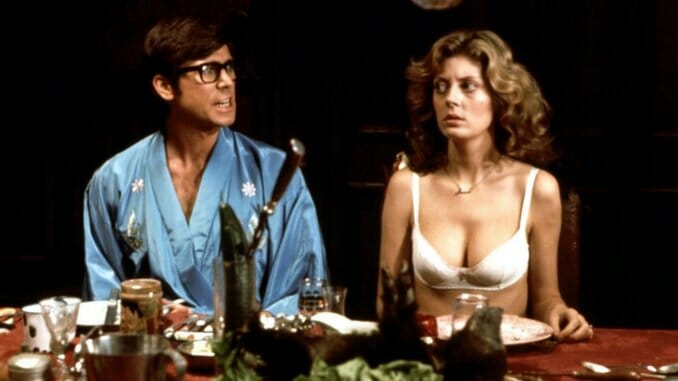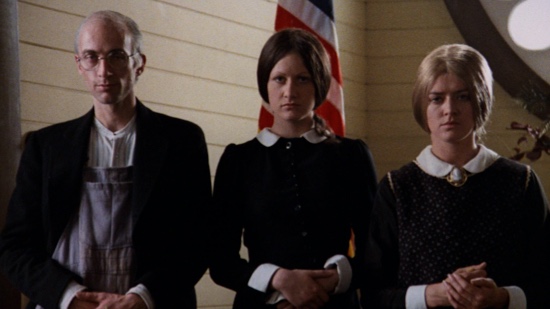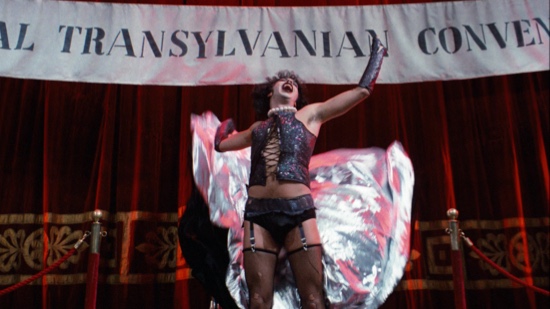Autumn Classics: The Rocky Horror Picture Show (1975)
Forty-five years have transformed the movie’s outsider camp into beloved tradition.

The midsize midwestern city where I live has been running a Rocky Horror stage show at the downtown theater annually (except this year, obviously) for more than a decade. The cast has a few long-time regulars and a few folks who play in it if they’ve got enough time in September and October for the rehearsals and the show: New cast members get branded with a scarlet “V” for joining the local phenomenon (as my fiancée did the year she took the stage). Last time I went, two little old ladies in the back row were among the most enthusiastic guests. The audience heckles the characters line for line the entire show.
The musical—with a story that lives at the vertex where gay panic and the high camp of drag meets with sci-fi and horror B-movies and the music of the mid-20th century—seems to have become pretty safe stuff. It is a “bad” movie that knows exactly what it’s doing. It is avowedly and proudly ridiculous. It is one of the most profitable movies ever. At 45, as the country seems stuck in the same exhausting arguments about what sex is allowable, what gender is recognized, what families are desirable and which of them are unnatural, The Rocky Horror Picture Show and the unfettered sensibility it celebrates are now basically considered communal fun and a Halloween touchstone in many communities.

Two unbearably square youngsters, Brad Majors—A Hero (Barry Bostwick), and Janet Weiss—A Heroine (Susan Sarandon), decide to promise themselves to each other on the same day another of their friends is married. As they drive out into the country to try to inform the old professor they have in common, a rainstorm and a flat tire strand them at a twisted mansion inhabited by strange characters. It’s clear right away that Brad and Janet have fallen in with a bad crowd, but it’s worse than they thought: space aliens (from the planet Transexual in the galaxy of Transylvania)!
Their ringleader is the diabolical, deranged, deviant Dr. Frank-N-Furter (Tim Curry in the role his entire prolific, eclectic career never did manage to eclipse, and not for lack of trying). Frank-N-Furter is a mad scientist whose only goal is, as he puts it, “absolute pleasure.” To that end, he’s kidnapped the very professor Brad and Janet were trying to reunite with, Dr. Scott (Jonathan Adams), and is trying to create the perfect companion: Rocky.
Brad and Janet find themselves trapped in Frank-N-Furter’s debauchery, which is only stopped when his fellow Transylvanians decide he’s gone too far and bring a tragic end to creator and creation. As for Brad, Janet, Dr. Scott, and their buttoned-down All-American lifestyle, they’ve been forever changed.

Of course, the plot of this movie, adapted from a UK stage show called The Rocky Horror Show, is hardly the point of it. It’s the craziness, the transgression, the camp, that bring people back, year after year to midnight show after midnight show. Curry’s Frank-N-Furter is an absolute menace, flaunting his physicality and sexuality with infectious confidence. The facial expressions Curry pulls off—the gleeful naughtiness he exudes—is enough to make you snicker randomly when you remember them the next day. Combine the manic weirdness of Curry and the other Transylvanians with the hammy performances Bostwick, Sarandon and Adams put in and the over-the-top narration provided by Charles Gray’s Criminologist, and there is simply no easy way to explain what kind of experience you get with this movie. Even 45 years on, it feels like the quirky creation of an obliviously earnest author.
There’s the music, too, did I mention that?
Between the slamming soundtrack and lines so cheesy that they cling to your cortex after just a couple of viewings, this is one of the most quotable and most hummable of movie musicals, coming out about a decade after the bubble had burst for movie musicals.
-

-

-

-

-

-

-

-

-

-

-

-

-

-

-

-

-

-

-

-

-

-

-

-

-

-

-

-

-

-

-

-

-

-

-

-

-

-

-

-









































